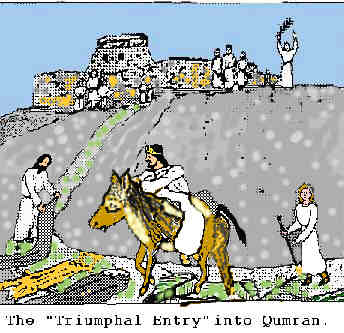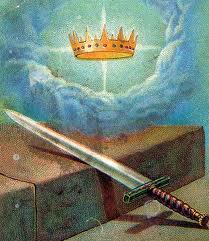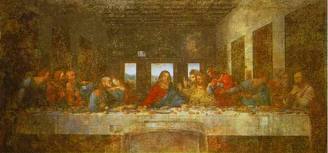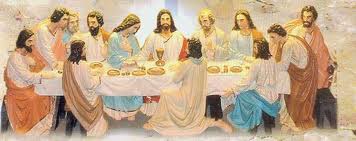| '
"The Last Supper" or
"Lord's Supper"
is traditionally celebrated on the
Thursday before Easter Sunday,
with "Maunday Thursday" being the
day to celebrate the "Last Supper", Good Friday celebrated by
some as the day of the crucifixion, and of course Easter Sunday celebrates
the resurrection of Christ "very early on the first day of the
week." Once the Bible Codes known as "Gospel Pesher"
became generally available for everyone to read who really is interested
to know the real dates, places, and actual historical events, it can be
said with reasonable certainty that the only one of these traditions that
is truly accurate is that the "Lord's Supper" was really held on
a Thursday evening. And that Thursday evening was March 19, 33 AD.
There were two "triumphal processions" involving a donkey (ass)
and palm branches, one on Monday, March 2, 33 AD at 2 PM starting at the
"Queen's House", and the second on Thursday, March 19, 33 AD at
noon.
There
were also three "cleansings of the temple" recorded in the
gospels, two in John and one in the other gospels. The reason that
none of these 5 controversial "happenings" created enough of a
stir to get Jesus arrested, or killed in a riot is that they all occurred
at or near the Qumran monastery, not at the city of Jerusalem some 14
miles distant over treacherous desert paths which must be walked at night
because of the stifling daytime heat most of the year in this
area. Jesus was at the times all these things happened the
chosen "Messiah" (David King) of the Essenes, and had the right
to do all these things by virtue of his position. Hardly
anyone in the city of Jerusalem knew what he was up to, or why. His
actions were quite invisible to the general populace. Mister
Cellophane Man of 33 AD.

AD
33
Monday March 2 11
AM Ain Feshkha [JESUS]
Arrives at Ain Feshkha. Sends messenger
to prepare ceremonial animal at the queen's
house, the Manger (Mark
11:1-2, Luke 19:29-30, Matt. 21:1-2)
noon He leaves Ain Feshkha
1 PM queen's house Messenger arrives at queen's
house (Mark
11:4)
2
PM
Jesus arrives at queen's house.
He mounts the ceremonial
animal (Mark 11:6-8)
3 PM Qumran
He and the procession arrive
at Qumran
(1 hour walking pace)
(Mark 11:9-10)
He goes to the temple-treasury
at the time for money
collection.
No fulfillment
has occurred for those
expecting a Restoration at
SS3969, 1st pos., Sam
31st.
He says it is because of the
financial corruption,
and
overthrows the furniture
for the banking system
(Luke 19:45-46, Matt. 21:12-13).
Thursday March
19
noon Ceremonial
procession repeated
at equinox position.
(John 12:12-13)
"On the next day much people
that
were come to the
feast, when they heard that
Jesus was coming to
Jerusalem, 13 Took branches
of palm trees, and went forth
to meet him, and cried, Hosanna:
Blessed is the king of Israel
that cometh in the name of the
Lord.
14
And Jesus, when he had
found a young ass, sat
thereon; as it is written,
15 Fear not, daughter of Sion;
Behold, thy king cometh, sitting
on an ass's colt."
Jesus
and the Riddle of the Dead Sea Scrolls --- page 235-237
 |
The Prophecy that Failed,
and failed repeatedly during the 3
1/2 years that Jesus was an Essene Messiah at Qumran was called the "Restoration".
In this prophecy, God [Yahweh] would cause the
Romans to "disappear", and a descendent of King David
would be king of the Jews
once more. Not only that, but the Jews would rule over the
entire world! The Zealots wanted to fight to
achieve this objective, but peaceful Essenes, such as Jesus,
depended on God to achieve this entirely by a miracle,
such as in their scriptures was the crossing of the Red Sea and
the falling down of the walls of Jericho.
|
|
|
THE
LAST SUPPER
Thurs. March 19, 33 AD 3 PM
Ain Feshkha Jesus begins the process of full entry
into the celibate life. He sends deacons
to go and prepare the table (Mark 14:
12-16, Luke 22:7-13, Matt 26:17-19)
6
PM Qumran The evening
communal meal
begins, in the vestry (Mark 14:17,
Matt 26:20,
John 13:2-11)
7
PM
Jesus blesses the fermented wine,
the
common drink (Luke 22:17)
8
PM
At 8 PM Jesus is permitted to
officiate
at the communion, as he
has returned to
the celibate state.
As he blesses and breaks the bread,
he gives it symbolic meaning
(Mark 14:22, Luke 22:19,
Matt 26:26)
9
PM
The cup of sacred wine is blessed
(Luke
22:20). Judas leaves, to
send a message to Pilate in
Jerusalem that the
wanted men
are at Qumran. (Jn 13:30)
9:05 PM
Peter moves down from the
prince's seat to the eastern
deacon's seat, so
he now can
converse with Jesus
(John
13:36, Luke 22:24-29).
For the remainder of the hour
Jesus conducts
discussion by
question and answer.
(John 13:36-14:31, Luke 22:31-38)
10
PM
At the close of the session, they
sing a hymn and go out to the east
side of
the monastery building
(John 14:31, Mark 14:26, Matt
26:26-30).
Jesus
and the Riddle of the Dead Sea Scrolls --- page 237-238

"The Last Supper" by Leonardo DaVinci
|
|
The Last Supper
as described by Dr. Barbara Thiering,
PhD in
"Jesus and the Riddle of the
Dead Sea Scrolls"
"The Last
Supper and the trial of Jesus took place in the vestry, a long room
running down from the south-east corner of the courtyard that had been
the substitute sanctuary. The remains of the fireplace at
which Peter stood during the trial are still to be seen there."
"All gospels
say that the crucifixion and events preceding it took place in
"Jerusalem", using the plural form of the word.
[explanation here] As has been seen, the distances of places given
in the gospels, measured in stadia, fit exactly the outposts of Qumran,
but remain vague when related to Jerusalem."
"The book of
Revelation speaks of "the great city which is spiritually called
Sodom and Egypt, where their Lord was crucified". [Rev. 11:7]
Qumran was near the ancient site of Sodom, and the name also reflected a
criticism brought by the opponents of the male celibate order meeting
there, headed by Judas. Qumran could also be called
"Egypt" when the Therapeutae met there, as has been seen."
"John's gospel makes a point of saying that the notices over the
crosses could be read from the "city". This would
have been unlikely if they were set up outside the heights of Jerusalem,
but easy if the crosses were set up, as other indications show, on the
southern esplanade at Qumran, only a matter of yards south of the back
entrance and on the same level."
"When
Qumran had been set up as a New Jerusalem, its various areas had been
called after those in the capital, making it a small scale
reproduction. The aqueduct running down the center became the
"Kidron"; on its west were the "city" and the
"temple"; on its east, the large monastery building was the
"Mount of Olives". The large hall for villagers on the
south side outside the walls was a "garden", as this was a name
for a place for villagers."
"While the
long courtyard to the west of the round well had originally been the
sanctuary, the vestry south of the well was thought of as the
"city", as it was the place where the priests ate their meals
and changed out of their vestments into ordinary garments. Here
they were "in the body", a stage below their holier state in
the sanctuary. The room, ten cubits or five yards wide and
some thirty cubits long, had two sections, the northern one raised a
cubit above the southern, so that it acted as a dais to the southern
one. The northern part, where the table stood, was the
"upper room" (katalyma). The table was
placed east-west across it, not far from the edge of the dias.
It was this arrangement that set the basic pattern for a Christian
church: the holy table on a raised platform, with the communion rail at
the edge of the dais."
"At 6 PM,
thirteen men came to this table and took their places. The
pattern of seating had been long established. Jesus and
Jonathan Annas sat in the centre, Jesus as the King on the west and
Jonathan as the Priest on the east. They were on elevated
couches a little back from the table itself, and in front of them, nearer
the table, were their respective Seconds, Peter in front of Jesus and
Judas in front of Annas. Peter acted as a "son" to Jesus
in his position of king, and Judas had just formed the alliance with
Annas that placed him there."
"On
the south side of the table, opposite the double place in the centre, was
John Mark, the Beloved Disciple. The other members were
distributed on either side of the centre, both the north and south of the
table."
"The meal, a regular evening meal such as was held every night by
the sectarians, was to last four hours, the first two being for taking
common food to satisfy hunger, the next two for the sacred
part. In each part, the first hour was for solid food, the
second for drink."
"It was based on a meal of villagers, where the owner of a house
acted as host to guests, including a visiting priest and levite.
The host took the seat of the king, and Jesus, in this position for the
first two hours, did the work of the host. One of these
duties was to wash the feet of his guests, including recipients of
welfare who may have been invited to the table. Jesus
performed this task at the beginning of the meal, then resumed his place,
to preside over the serving of the common food. At 7 PM he
blessed and distributed a cup of fermented wine, the common drink, taken
by some but not all of those present (as some had the practice of orders
like the Therapeutae, abstaining from all wine)."
"At 8 PM came the time for the sacred food, the
communion. Jesus could partake of it, as he was now restored
to the celibate state. At this point, as John's gospel
records, "he was troubled in the Spirit". A play on
words conveys that he turned to Jonathan Annas beside him (called the
Spirit in one of his many titles) and contested his position."
"While the issue was in doubt, it was also doubtful which of the
two, Peter or Judas, would be his Second during the
communion. If he moved to the priestly side, it would be
Judas. When he said "One of you will give beside
me" (paradidomi in Greek), there was another play on words:
it could mean either "betray" or act as assistant
minister". He pointed to Judas, but Peter, sitting in
front of him, could not see where he was pointing. Peter
beckoned to John Mark, sitting on the opposite side of the table, who was
able to show him that Jesus was claiming the priestly side. At the
same time John Mark changed from one side of his double seat, "the
bosom", to the other, to be opposite Jesus. Jonathan
Annas yielded, and moved to the position of king."
"Judas
now knew that in Jonathan Annas he had the extra ally he needed. He
stayed for another hour, acting as an assistant to Jesus in the
distribution of the communion bread. But shortly after 9 PM,
when the sacred wine was served, he had reason to make his excuses and
leave, for he was one of those who did not drink wine."
"Until 10 PM Jesus presided in the position of priest, receiving and
answering questions according to the rules of order. Then it
was time to close proceedings; at 10 PM they sang a hymn, and Jesus said
"Arise, let us go hence."
Jesus
and the Riddle of the Dead Sea Scrolls --- page 105-107
|
|


